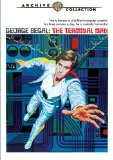| Reviews & Columns |
|
Reviews DVD TV on DVD Blu-ray 4K UHD International DVDs In Theaters Reviews by Studio Video Games Features Collector Series DVDs Easter Egg Database Interviews DVD Talk Radio Feature Articles Columns Anime Talk DVD Savant Horror DVDs The M.O.D. Squad Art House HD Talk Silent DVD
|
DVD Talk Forum |
|
|
| Resources |
|
DVD Price Search Customer Service #'s RCE Info Links |
|
Columns
|
|
|
Terminal Man, The
"They want you next."
"Quit kiddin' around."
Cold, impersonal, distant Frankenstein re-imagining―and a fairly perverse jab at its horror/suspense genre conventions. Warner Bros.' Archive Collection, their M.O.D. (manufactured on demand) service, has released The Terminal Man, the 1974 adaptation from Warner's of author Michael Crichton's 1972 novel, written and directed for the screen by Michael Hodges, and starring George Segal, Joan Hackett, Richard Dysart, and Jill Clayburgh. Not successful with either the public or the critics when first released, The Terminal Man plays well today as a rigidly-controlled visual experience, with a positively ruthless hands-off demeanor...but that diffident stance and crushingly bleak viewpoint turns off a lot of viewers.
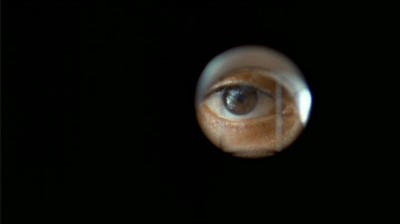
Brilliant machine intelligence engineer Harry Benson (George Segal) is a violent, paranoid psychotic who experiences blackouts and who believes machines are winning the war against humans. A team of scientists and doctors, headed up by Dr. Arthur McPherson (Donald Moffat) and Dr. John Ellis (Richard Dysart), believe Benson is suffering from a form of para-epilepsy, and that an atomically-powered postage stamp-sized computer implant in Benson's brain will end his seizures by stimulating "pleasure" signals to counter his violent episodes. Dr. Janet Ross (Joan Hackett), a psychiatrist on the team, isn't so sure, but she acquiesces when Benson reaffirms his wish to go ahead with the risky procedure. Unfortunately, Benson's brain learns very quickly what to do to get more of those "pleasurable" signals, and soon he's tripping out on impulses...impulses that soon overload his brain, pushing him again into his violent, psychotic seizures.
PLOT SPOILERS WARNING!
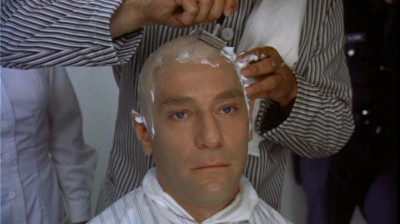
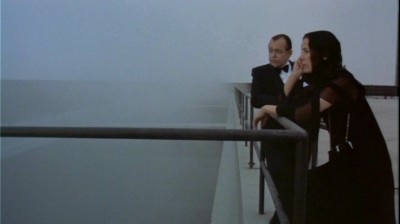
A movie that seems to tick off a lot of viewers and critics, The Terminal Man stubbornly refuses to give the audience what it wants―or at least what it expects in a horror techno-thriller―deemphasizing the more familiar, flashy conventions to instead focus, with an almost bizarre rigidity, on presenting an exceedingly desolate view of a computerized world devoid of human feeling. English director Mike Hodges (the brilliant Get Carter and even better Pulp, the fun Flash Gordon) first creates a visual world that seems as hospitable as a Petri dish. With art direction that consists mainly of whites and blacks and grays and blues and greens, the dark utilitarian hallways and labs and even homes in The Terminal Man all have sharp, unforgiving corners and hard, shellacked surfaces, with the sound pinging uncomfortably off of them. The only time we see sunlight and trees and the grass, is at the very end of the movie...in a cemetery.
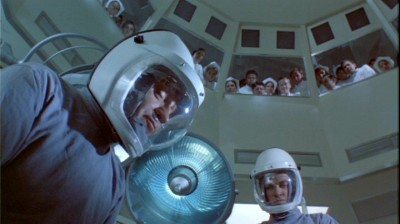
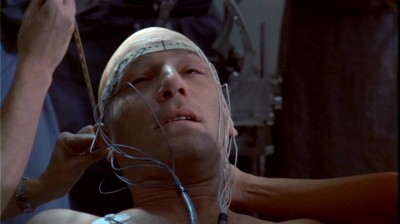
Within this unforgiving, almost alien world, Hodges populates it with cynical, dour human beings, cut off by their technology, who seem only capable of communicating with each other through calculated jabs and snarky asides (the one scientist who seems capable of worrying about Segal, reserved Hackett, is snidely referred to as "Miss Warmth" by a snotty nurse). The opening scene, where Dysart and Moffat discuss their patient, is conducted in the presence of a P.R. rep, James B. Sikking, who seems more interested in the celebrities around him than what actually is going to happen to Segal ("Is that Paul Newman there?"). Even though we're told Segal is really sick, and not just a violent offender (he beat his ex-wife and tried to kill two people during a seizure), he's treated with an off-handed disregard that suggests a lab rat rather than a human being in need of help. His chief handler, Dr. Robert Morris (the sepulcherial Michael C. Gwynne), rarely even looks Segal in the eye, showing an impatience with having to deal with him directly, while dismissing Segal's high intellect. When Segal is transported by the cops to the institute for treatment, the cop hands Morris a clipboard and states, "you have to sign for this delivery," as if Segal was a shipment of test tubes. I'm not even sure if there was a scene where Dysart, the surgeon performing the operation, speaks directly to his patient, Segal (but we do get to see distrustful Dysart spurn a locker in his own locker room and put his wallet in his sock before surgery). And throughout the movie, in a creepy visual motif, the starring eyes of guards watch Segal through a peephole while making jokes about his condition ("Are they really going to put wires in his brain? No sh*t."). Segal's "treatment" shows almost no sign of accompanying sympathy or humanity.
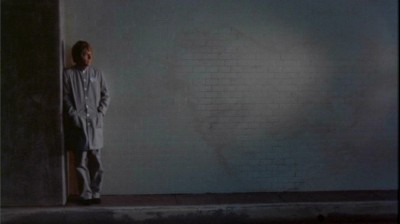
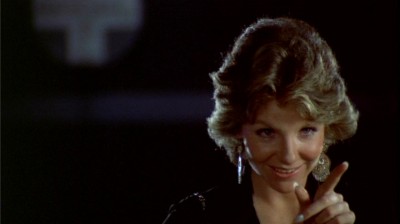
Further underscoring this depersonalized worldview (and reinforcing Segal's belief in technology-as-hostile-enemy), The Terminal Man's rather remarkable surgical scene brilliantly subverts all those thousands of hours of TV medico shows we grew up on (Medical Center and Marcus Welby, M.D. were huge hits in 1974), where the kind, caring, healing hands of the dedicated surgeons worked quickly to save a life. Here, Dysart and Gwynne, decked out in futuristic helmets like two aliens, dispassionately work on Segal like he's a broken-down DeSoto. Eyes glued to their monitors, not making any moves unless their computer tells them where and when and how far to make the incisions and insert the probes, the doctors here call boring into a person's head "carpentry," before Dysart tells an anecdote about his mentor who dismissed any qualms about brain surgery: "It's just a head―cut it!" They can't even work up any excitement over what they're doing ("This is the only work I know that's boring and nerve-wracking at the same time"), or what they've done (Dysart gets an equally impersonal party after the successful operation, while Segal gets wheeled back to his room alone―no party for him).
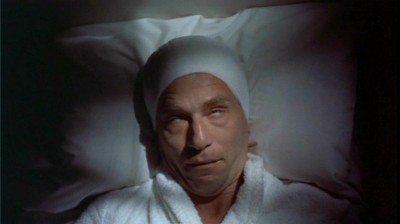
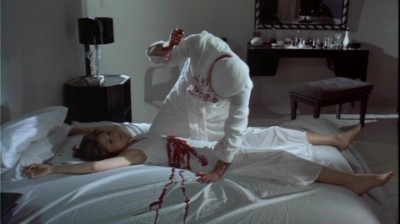
All of this is brilliantly if coldly staged by Hodges (with the help of Richard H. Kline's chilly cinematography), who keeps the audience at arms' length through his antiseptic art direction and his neutered performances (when someone states Segal was on Thorazine, my first thought was, "I thought they were all on Thorazine."). However...I can see where this almost suicidal atmosphere can be wearying for viewers not willing to plumb the depths of nihilistic depression here. If Hodges was deliberately going for a movie that would totally alienate 99% of its potential audience by saying, "this newly mechanized world is completely devoid of hope or feeling...and my movie won't be exciting showing that world," then he succeeded masterfully. If, however, he wanted us to care even a little bit about Segal (an actor we usually can't help but "like" in a picture), or if he wanted us to get some of our genre jollies we expect from horror thrillers like The Terminal Man, he failed. Certainly beginning the movie with Segal already ill and tranqued-up dampers any audience identification we might have for him other than simple pity (like the similar Frankenstein monster), while Hodges largely avoids the sticky notion of Segal's paranoid fantasies concerning machines taking over the world (except for a brief lecture scene where William Hansen assails Dysart, telling the surgeons they've picked the wrong subject for their questionable experiments). Instead, the surgery is blamed for everything Segal does, making things a little too easy for the audience when he starts killing people. Other problems with the plot include no background or context for Jill Clayburgh's character (she makes sense in the book), so we feel almost nothing when she's slaughtered in slo-mo by Segal (a visually arresting scene, nonetheless). And what about Segal's pre-operation plan to know all the addresses of the doctors, along with Clayburgh bringing him clothes and wig before the procedure? Was he planning on zapping them all, anyway, as part of his paranoia? Again, the movie doesn't explain this; we have to guess (maybe it got lost in the obvious post-production chopping that took place here).
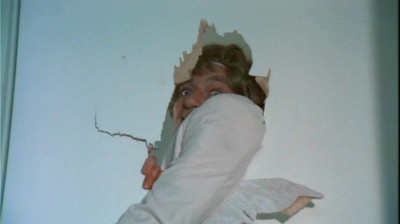
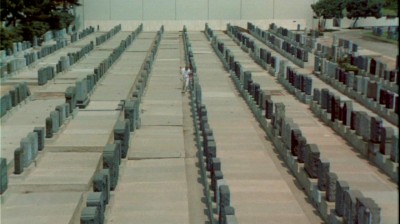
The most controversial element of The Terminal Man has to be that ending, though, where Segal stumbles into a newly-dug grave, has a seizure, and is shot to death by a hovering helicopter (even though he's clearly offering no resistance). Contrary to viewers and critics who call this ending anti-climatic (and visually dull), I find it quite brave of Hodges. It's as if Hodges wants to deliberately poke his finger in the eye of your expectations for a slam-bang action finale to this horror thriller. After all, what could be less cinematic, less exciting (and more sad), than a man getting shot deep down inside a six-foot hole in the ground? If you wanted Segal to somehow run around and shoot it out with the cops, you're going to be deeply disappointed here (maybe even angry). However, if you bought Hodge's hopeless, impersonal, anti-genre approach from the beginning, this ending makes perfect sense, both visually and thematically. It's an aesthetic choice that's quite daring (and certainly not as audience pleasing-explosive as the usual endings for similar doctor-engineered Frankenstein creations)...one almost guaranteed to chill the box office.
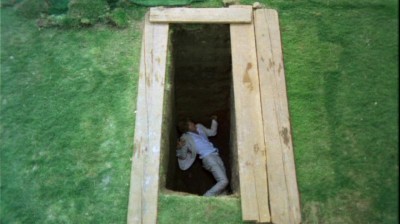
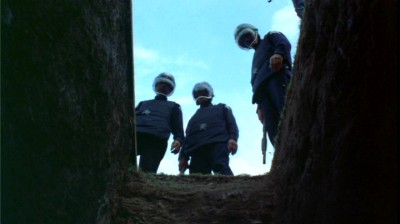
The DVD:
The Video:
The anamorphically enhanced, 1.85:1 widescreen transfer for The Terminal Man has some video noise and grain, with a medium-sharp picture. I never saw the original in the theater (my parents said it was too violent―which is exactly why I wanted to see it so bad), so I can't speak to the fidelity of this transfer. However, if I had to guess, I'd bet it was sort of gauzy, anyway, and maybe a little grainy with the available light and stock used here.
The Audio:
The Dolby Digital English mono audio track is fine, with little hiss and a relatively stable level. No subtitles or close-captions.
The Extras:
An original trailer is included (a pretty bad one, even by 1970s standards).
Final Thoughts:
Frankenstein updated to the computer age. Writer/director Mike Hodges doesn't want you anywhere near this film (and don't you have any genre fun!), and that's a daring move for what everyone involved was probably expecting from this Michael Crichton adaptation: another exciting Westworld-type thriller. Definitely an acquired taste, and there are problems with the script...but the overall effect is chilly, and chilling. I'm highly recommending The Terminal Man.
Paul Mavis is an internationally published film and television historian, a member of the Online Film Critics Society, and the author of The Espionage Filmography.


|
| Popular Reviews |
| Sponsored Links |
|
|
| Sponsored Links |
|
|
| Release List | Reviews | Shop | Newsletter | Forum | DVD Giveaways | Blu-Ray | Advertise |
|
Copyright 2024 DVDTalk.com All Rights Reserved. Legal Info, Privacy Policy, Terms of Use,
Manage Preferences,
Your Privacy Choices | |||||||









